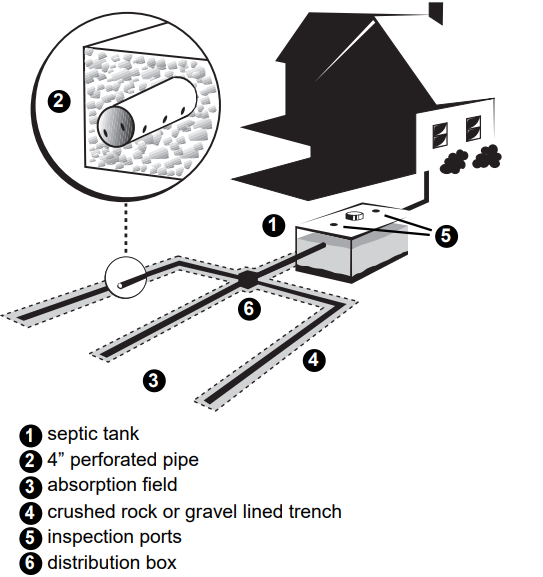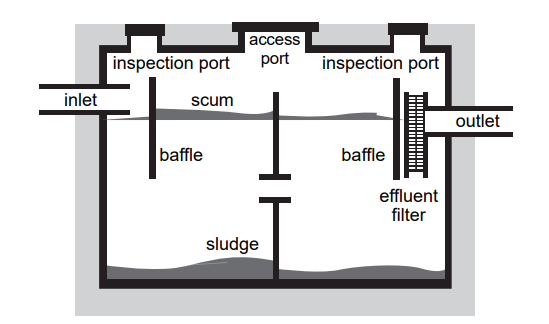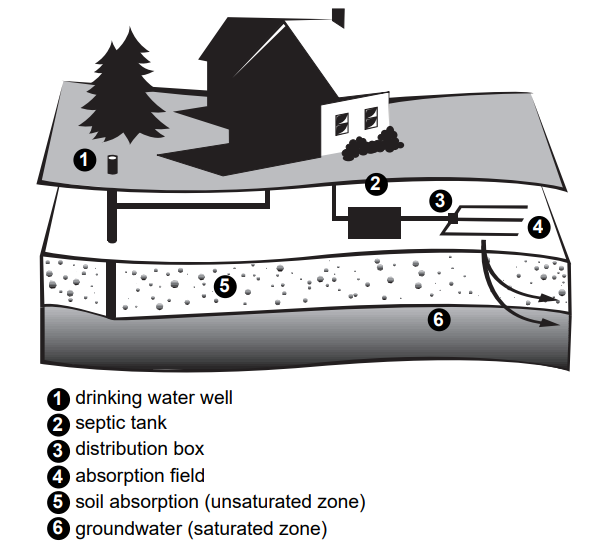Septic Operation and Maintenance Brochure
So . . . now you own a septic system
More than 25 million homes, encompassing almost 25 percent of the U.S. population, dispose of domestic wastewater through onsite (unsewered) systems. According to the American Housing Survey for the United States, in 1993 1.5 (million) out of every 4 (million) new owner occupied home starts relied upon a form of onsite sewage disposal.
One of the major differences between owning an unsewered versus a sewered home is that unsewered wastewater treatment and disposal systems must be\ maintained by the homeowner. Treatment and disposal of wastewater should be one of the primary concerns of any homeowner in an unsewered area.
The most common way to treat and dispose of wastewater in rural homes is through the use of an onsite disposal system. The majority of onsite disposal systems in the United States are septic systems.
Typical Septic System Fig. 1

HOW IT WORKS
A typical septic system contains two major components: a septic tank and the absorption field (see Figure 1). Often, a distribution box is included as part of the system to separate the septic tank effluent evenly into a network of distribution lines that make up the absorption field. The septic tank is usually made of concrete, fiberglass, or plastic, is typically buried and should be watertight. All septic tanks have baffles (or tees) at the inlet and outlet to insure proper flow patterns (see Figure 2). Most septic tanks are single compartment; however, a number of states require two-compartment tanks or two single compartment tanks in series.
While typically designed to hold a minimum of 750–1000 gallons of sewage, the size of the tank may vary depending upon the number of bedrooms in the home and state and local regulatory requirements. The primary purpose of the septic tank is to separate the solids from the liquids and to promote partial breakdown of contaminants by microorganisms naturally present in the wastewater. The solids, known as sludge, collect on the bottom of the tank, while the scum floats on the top of the liquid. The sludge and scum remain in the tank and should be pumped out
periodically (see Figure 2).
Solids that are allowed to pass from the septic tank may clog the absorption field. Keeping solids out of the absorption field not only prevents clogging, but also reduces potentially expensive repair or replacement costs and helps ensure the ability of the soil to effectively treat the septic tank effluent. Therefore, an additional safeguard in keeping solids out of the absorption field is the use of effluent filters on the outlet of the septic tank (see Figure 2).
Cross-section of a two-compartment septic tank

The wastewater (effluent) coming out of the septic tank may contain many potentially disease-causing microorganisms and pollutants (i.e., nitrates, phosphates, chlorides). The effluent is passed on to the absorption field through a connecting pipe or distribution box. The absorption field is also known as the soil drainfield, the disposal field, or the leachfield. The absorption field contains a series of underground perforated pipes, as indicated in Figure 1, that are sometimes connected in a closed loop system, as illustrated on the front cover, or some other proprietary distribution system
The effluent is distributed through the perforated pipes, exits through the holes in the pipes, and trickles through the rock or gravel where it is stored until absorbed by the soil. The absorption field, which is located in the unsaturated zone of the soil, treats the wastewater through physical, chemical, and biological processes. The soil also acts as a natural buffer to filter out many of the harmful bacteria, viruses, and excessive nutrients, effectively treating the wastewater as it passes through the unsaturated zone before it reaches the groundwater (see Figure 3).
Wastewater treatment and disposal in soil

Wastewater contains nutrients, such as nitrates and phosphates, that in excessive amounts may pollute nearby waterways and groundwater supplies. Excessive nutrients in drinking water supplies can be harmful to human health and can degrade lakes and streams by enhancing weed growth and algal blooms. However, the soil can retain many of these nutrients, which are eventually taken up by nearby vegetation.
What to Put In, What to Keep Out
• Direct all wastewater from your home into the septic tank. This includes all sink, bath, shower, toilet, washing machine and dishwasher wastewaters. Any of these waters can contain disease-causing microorganisms or environmental pollutants.
• Keep roof drains, basement sump pump drains, and other rainwater or surface water drainage systems away from the absorption field. Flooding of the absorption field with excessive water will keep the soil from naturally cleansing the wastewater, which can lead to groundwater and/or nearby surface water pollution.
• Conserve water to avoid overloading the septic system. Be sure to repair any leaky faucets or toilets. Use low-flow fixtures.
• Do not use caustic drain openers for a clogged drain. Instead, use boiling water or a drain snake to open clogs.
• Do not use septic tank additives, commercial septic tank cleansers, yeast, sugar, etc. These products are not necessary and some may be harmful to your system.
• Use commercial bathroom cleaners and laundry detergents in moderation. Many people prefer to clean their toilets, sinks, showers, and tubs with a mild detergent or baking soda.
• Check with your local regulatory agency if you have a garbage disposal unit to make sure that your septic system can accommodate this additional waste.
• Check with your local regulatory agency before allowing water softener backwash to enter your septic tank.
• Your septic system is not a trash can. Do not put grease, disposable diapers, sanitary napkins, tampons, condoms, paper towels, plastics, cat litter, latex paint, pesticides, or other hazardous chemicals into your system.
• Keep records of repairs, pumpings, inspections, permits issued, and other system maintenance activities.
• Learn the location of your septic system. Keep a sketch of it handy with your maintenance record for service visits.
• Have your septic system inspected every 1–2 years and pumped periodically (usually every 3–5 years) by a licensed inspector/contractor.
• Plant only grass over and near your septic system. Roots from nearby trees or shrubs may clog and damage the absorption field.
• Do not drive or park over any part of your septic system. This can compact the soil and crush your system.
In summary, understanding how your septic system works and adhering to these few simple rules will ensure that your septic system is a safe and economical method for treating and disposing of your wastewater onsite.
For more information regarding the care of your septic system, contact your local health department.
More information about septic systems is available from the National Small Flows Clearinghouse (NSFC) through other brochures in this series:
Groundwater protection and your septic system, Item #WWBRPE21
The care and feeding of your septic system, Item #WWBRPE18
For more information about this or other NSFC products, please contact us by writing to:
National Small Flows Clearinghouse
West Virginia University
P.O. Box 6064
Morgantown, WV 26506-6064
or phone:
(800) 624-8301, (304) 293-4191
or fax: (304) 293-3161
